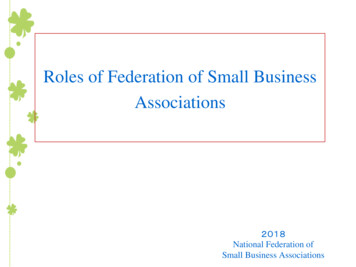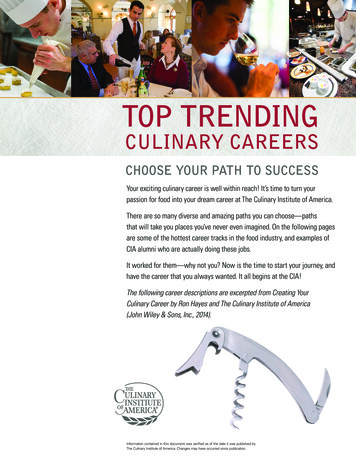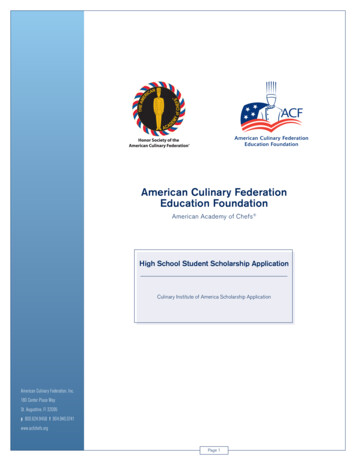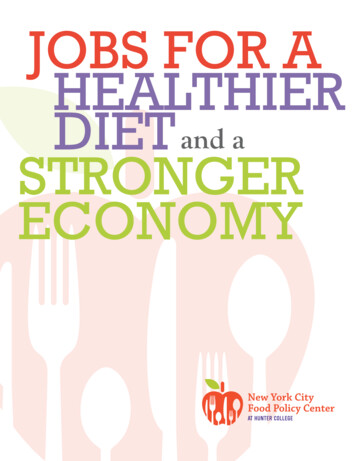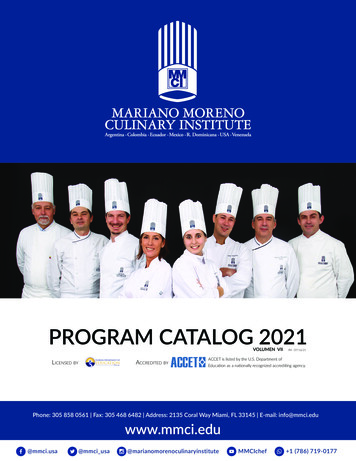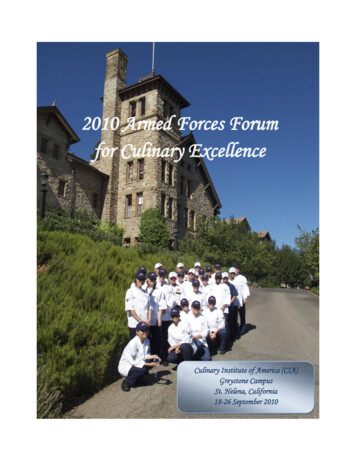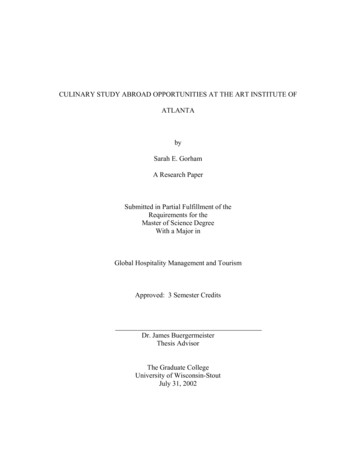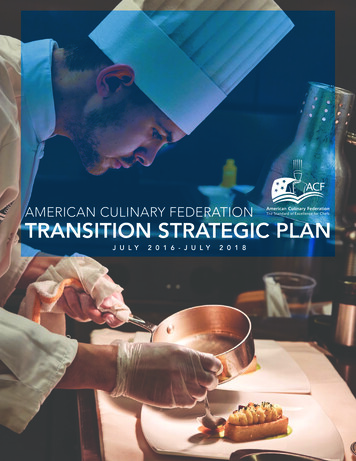
Transcription
American Culinary FederationTransition Strategic PlanJ u ly2 0 1 6 - J u ly2 0 1 8
This Strategic Plan of ACF contains the strategic initiatives and action stepsmoving the national organization forward over the next two years. This plan ismeant to serve as a bridge from the 2011-2016 ACF Strategic Plan to the nextplan to be authored over the next two years and ratified in 2018.About This PlanThe American Culinary Federation Transition Strategic Plan for July 2016 - July 2018focuses on serving the needs of our membership:1.2.Once adopted by the ACF Board of Governors, this transition StrategicPlan will be the job description of the Board of Directors as a leadershipentity. Through the Strategic Plan, along with the ACF bylaws and policiesand procedures, the Board of Governors has the responsibility of holdingACF leadership accountable for the initiatives within. Even through Boardleadership transition via election and other matriculation, the course of ACFshould be guided successively by the Strategic Plan.This transition plan is an organic document. It is our compass for the futurebut should not be so inflexible as to bind us to strategies that are ineffective.This plan can, should and will be revised as needed and as agreed upon andallowed by ACF policy.
table of contents2 About The American Culinary Federation4 Our Mission4 Our Values5 Our Vision5Key Success Factors5 Our Objectives6 Our Strategies7 Alignment11 Growth14 Services17Finance19 APPENDIX
about the americanc u l i n a ry f e d e r at i o nThe American Culinary Federation, Inc. (ACF), a professional organization for chefsand cooks, was founded in 1929 in New York City by three chefs’ organizations:the Société Culinaire Philanthropique, the Vatel Club and the Chefs de CuisineAssociation of America. Since our inception, little has changed in our principalgoals. We are an organization based on promoting the professional image ofAmerican chefs worldwide through education of culinarians at all levels.In 1976, ACF forever changed the culinary industry by elevating the position of theexecutive chef from service status to the professional category in the U.S. Departmentof Labor’s Dictionary of Official Titles. Since this change, the culinary industry and ourorganization have grown tremendously. In fact, ACF is the largest professional chefs’organization in North America. We are made up of more than 17,500 members thatbelong to more than 150 chapters in four regions across the U.S.Today, ACF is the leader in offering educational resources, training, apprenticeship,competitions and programmatic accreditation designed to enhance professionalgrowth for all current and future chefs and pastry chefs. In addition, ACF operatesthe most comprehensive certification program in the world. ACF is home to ACFCulinary Team USA, the official representative for the United States in majorinternational competitions, and to the Chef & Child Foundation, founded in 1989to promote proper nutrition in children and combat childhood obesity.If you are not part of our elite group of chefs, we invite you to join us and gainaccess to the best culinary resources available.AC F strategic pla njuly 2016 – j u ly 201 8pg: 2
executive summaryThe Board of Directors identified four fundamental strategies for theorganization to continue the success ACF has realized over the past 87 years.These strategies and action statements are broken down into four maincategories: alignment, growth, services and finance. These strategies willbe the blueprint the organization follows in formulating and executing therespective plans.Each strategy will contain a series of action statements deemed criticalto the attainment of the targeted strategy. Members of the current Boardof Directors have volunteered to sponsor the action statements throughimplementation with support from ACF’s national office and participationfrom the regions and chapters.The Strategic Plan, on adoption, will be effectively communicated andmarketed to all stakeholders for implementation. Key communicationcomponents will be utilized to facilitate the process.In 2009 the sitting ACF Board of Directors, led by incoming National PresidentMichael Ty, CEC, AAC, began the process of crafting a comprehensive StrategicPlan to guide ACF for the immediate future. After a nearly two year-long process,that goal became reality with the release of the 2011-2016 Strategic Plan. The planincluded many innovative initiatives and marked the first time that a Strategic Planof ACF has achieved measurable success. However, through Board attrition andother market pressures, some initiatives were left incomplete. In 2015, the currentACF Board of Directors appropriately embarked upon the writing of the nextStrategic Plan as laid out in the timeline from the 2011-16 plan.After considerable research and deliberation that included a staff and Boardsurvey, it was decided that the timing for a new five-year plan was not good.Instead, the creation of a two-year bridge plan was implemented. This effortwill allow the next Board, who will invariably be charged with many of theachievables in the plan, to have full input into its crafting. It will also allow time,as one of those achievables, for a comprehensive member survey. Lastly, itwill allow for a final summarization of the action steps from the previous plan,presenting a clean start for the next set of strategic initiatives.ACF s t rat e g i c p la nj u ly 2 0 1 6 – j u ly 2018pg: 3
MissionAt the fall 2015 Board of Directors meeting, the team met to revisit theStrategic Planning effort first undertaken in the summer of 2009. The team alsoused the session to build trust and understanding and to openly discuss criticalissues and major influences driving the culinary industry and ACF’s business.The result was recognition and closure of several strategic issues, an enhancedStrategic Plan (mission statement and strategies), and a footprint for eachregion and chapter to use as they better align their respective activities with theorganization’s direction. This document incorporates those improvements andwill solidify the direction of ACF.The ACF Mission Statement is a short, succinct statement outlining our businessgoals and defining our customers:The American Culinary Federation provides accredited educational programs,certifications, competitions and networking designed to enhance professionalgrowth for all current and future chefs and pastry chefs.ValuesDuring the strategy sessions, the Board of Directors captured a set of corevalues that reflect the history and fundamental principles embedded in ACF’s87-year history. These values have been a cornerstone of the organization,emphasizing the importance of not only what we do, but also how we do it.These values are:IntegrityHighPerformanceHonor our commitments; trust one another; promote character enrichment;value diversity in our workforce; exceed community environmentalexpectations; and exhibit fairness in all business practices.Perform in everything we do; learn to live with ambiguity and uncertainty;welcome future changes in our industry; learn to manage risk; usecommon sense; reward creativity and continuous improvement; andpromote lifelong learning.CommunitySatisfy our customers; value our employees; serve our membership; developstrong relationships; and support our community.ExcellenceShape our future through quality and character in everything we do; setappropriate goals and be accountable; develop leadership, empower employees;promote teamwork; take pride in what we do; adopt a “can do” attitude; enhanceour image; excel in customer service; and reward performance.AC F strategic pla njuly 2016 – j u ly 201 8pg: 4
VisionThe vision statement creates an image of our mission. The vision is theultimate journey through the challenges we face now and in the future. We,as members, must determine how our efforts impact our success along thatjourney. The ACF Board of Directors recognized the value of moving ourmembership toward a shared vision - one that energizes and motivates ourprofession to excel in service to our customers.ACF’s Vision Statement is:To be the leader in professional and personal development for the culinarycommunity, while promoting current culinary techniques and preserving thehistory and skills of our craft.Key Success FactorsObjectives The table, ACF Strategic PlanObjectives, Strategies and MeasurableOutcomes, identifies the essentiallinks between the Strategic Plan’sobjectives, strategies and measurableoutcomes. The objectives identifythe areas to monitor and measure toensure comprehensive success of theorganization and for the stakeholders.The strategies denote how theobjectives will be accomplished, andare written in broad, general terms.The measurable outcomes evaluateperformance. Specific annual targetsFoster Membership andProgram Growth Demonstrate FinancialStewardship Align ACF for long termsustainability through theStrategic Plan Provide qualitymember serviceswere developed to quantify resultsand track successes.The key action plans associated witheach strategy provide details of newinitiatives, or “actions,” that supportattainment of the strategies. ACF willcontinually evaluate and monitor eachof the strategies and action plans toensure successful implementation.The following pages of this StrategicPlan identify the objectives, strategiesand measurable outcomes vital toACF’s success.ACF s t rat e g i c p la nj u ly 2 0 1 6 – j u ly 2018pg: 5
Our StrategiesEach Strategy contains a series of action statements that are deemed critical to the attainment of thetargeted strategy. The current Board has volunteered to sponsor each of the action statements throughimplementation. Their individual sponsorship reflects a commitment to see the action to completion,utilizing support from the national office, regional and chapter participation. Progress will be reportedduring Board of Director meetings. The national office will maintain the information.ObjectiveStrategyMeasurable OutcomeAlignmentEmpowerment of ACFEntities and Analysisof Current and FutureOrganizationEmpowerment of Staff, Committees and Board of GovernorsMember SurveyLegal StructurePartnershipsMonitoring of Strategic PlanGrowthGrow ACFProfessional ChefsOrganizations that Hire ChefsEducational ProgramsChapter Business ModelCommunity EngagementServicesPromote thevalue of ACFRegional and National hipsPublicationsFinanceMaximize our financialperformance throughfiscal responsibilityRevised Financial ModelBudgetingDevelopment PlanOn the following pages, these Strategies and Action Statements are explained in additional detail.AC F strategic pla njuly 2016 – j u ly 201 8pg: 6
alignmentEmpowerment of ACF Entities and Analysisof Current and Future OrganizationACF, to achieve its maximum potential, must transition from functioningreactively and tactically when dealing with members, external organizations,internal committees and finances to a strategic business model. ThisStrategic Plan outlines a leadership structure that will encourage successfulimplementation, transitioning and the continuation of the planning processthrough generations of leadership to come.As work progresses toward a more businesslike approach to running theorganization, ACF needs to be cognizant that the Board of Directors shouldbe focused on strategy rather than tactics. Through the directives of theBoard of Governors and the Board of Directors, it is then the job of the ACFnational office and committees to handle the tactical aspects of running theorganization. In turn, the responsibility for monitoring the progress of eachStrategic Plan will be delegated to the ACF Internal Audit Committee, whichwill include a description of progress as part of its annual report.In addition to these administrative strategies ACF must look to its members,its partners and to the greater culinary community which it is a part of to alignitself with the needs of its own members, the desires of its partners and theinfluence of America’s food community.ACF s t rat e g i c p la nj u ly 2 0 1 6 – j u ly 2018pg: 7
Empowerment ofACF National OfficeEmpowerment ofCommitteesEmpowerment ofBoard of GovernorsThe ACF national office, in particularthe management, is experienced andknowledgeable in their applicableareas, and they are dedicated tothe betterment of ACF and theimplementation of the mission andvision. The Board of Directors willempower the ACF national officeby listening to their needs,recommendations and ideas. TheBoard of Directors will provide advice,oversight and trust that the nationaloffice will guide them to make educateddecisions for the organization’s benefitand financial stability.ACF and American Culinary FederationEducation Foundation (ACFEF)committees and commissions need toassume more responsibility indeveloping the organization, per theStrategic Plan. The committees/commissions need to establish or revisitpolicies and procedures. The ACF Boardof Directors would review and approvethe committees’ policies andprocedures. By coupling the policies andprocedures with the initiatives andmandates from the Board of Directors,the committees will become strongerand will assume more focused roles. Assuch, the Strategic Plan can be achieved.Once adopted by the ACF Board ofGovernors, this Strategic Plan will bethe job description for the Board ofDirectors, ACF’s leadership entity.Through the Strategic Plan, along withACF bylaws and policies andprocedures, the Board of Governorshas the responsibility of holding ACFleadership accountable for theinitiatives within the Strategic Plan.Even through Board leadershiptransition via election and othermatriculation, the course of ACFshould be guided successively by theStrategic Plan.Assume ResponsibilityAdoption of thein Developing ACFStrategic PlanBOARD OF DIRECTORS INEstablish/Revisit PoliciesMonitor Strategic PlanMAKING DECISIONS FOR THEand ProceduresImplementationACF BOARD OF DIRECTORSPROVIDES ADVICE, OVERSIGHTAND TRUSTACF NATIONAL OFFICE GUIDESBETTERMENT OF ACFEnsure ContinuationImplementation ofImplementation of theof Strategic PlanStrategic Plan TacticsStrategic Plan’s TacticsImplementation per Board ofDirectors SuccessionEmpowerment ofEmpowerment ofACF and ACFEF Committees andACF National OfficeAC F strategic pla njuly 2016 – j u ly 201 8Commissionspg: 8Empowerment ofBoard of Governors
CONDUCT aComprehensive MemberSurvey by the end of 2017During the Strategic Planning sessionsconducted by the ACF Board ofDirectors in 2015 and 2016,comprehensive Board and staff surveyswere conducted. The data compiledwas instrumental in not only thistransition plan, but also in the decisionto make it a shorter transition planrather than a five-year plan. Tocomplete the overall view of ACF, amembership survey must accompanythe two already completed. This datawill form the core set of information forthe next full plan to be started duringthe transition plan term.DETERMINE IF A STUDYinvestigating the merits ofthe current ACF legal andorganizational structureversus other possibleoptions is warranted.Both the staff and Board surveysindicated strong motivation toinvestigate these factors. If themembership survey has similarindicators then this discussionbecomes imperative.Investigate structure typesFormulate core dataavailable to ACF (association,desired and relatedfranchise, etc.)questions (4Q 2016)Research what otherorganizations do and whyCraft Member Survey(1Q 2017)Analyze costs involvedExamine staff andDeliver survey to members andBoard structure of ACFcollect results (2Q 2017)Compare to otherorganizationsCompile results and sharewith members by NationalConvention 2017Decide if changes ineither area are desiredACF s t rat e g i c p la nj u ly 2 0 1 6 – j u ly 2018pg: 9
ALIGNMENT of PartnershipsThere are more than 1 millionfoodservice workers in the UnitedStates, and ACF should be the leaderin food preparation and setting thestandards in the industry. ACF hasalienated certain sectors of theindustry in the past, which has resultedin the formation and development ofother organizations now in strongcompetition with the Federation.Barriers that were created many yearsago could be broken by opening ACFup to establishing industrypartnerships. The goal is to mutuallybond and work together to promotethe culinary profession, not to replaceor change these other organizations.This will be accomplished bydeveloping a list of foodserviceorganizations with similar missions,establishing which of theseorganizations currently haverelationships with ACF and analyzingthe return on investment of theexisting relationships. Then, ACFshould decide whether to strengthenthe relationship or discontinue it, andinvestigate the remainingorganizations to determine whichbear a potential for return oninvestment if an alliance is formedwith ACF, as well as reaching out tothose designated to seek partnershipopportunities.Now is the time to embrace ACF bybecoming leaders in the organizationand strenghening ACF’s image acrossthe United States. ACF should berecognized as an industry leader.MONITORINGof Strategic PlanACF must ensure that throughleadership changes, politics and thedaily distractions that affect us all, thatthe Strategic Plan is monitoreddiligently so that the growth andcontinuity of progress is maintainedfrom year to year and administrationto administration. This may beachieved through the following:Analyze for ROIConduct a review of currentsponsor relationshipsOrient, train and expectAnalyze for mission andgoal compatibilityAnalyze historical relationshipSet “Dream List” of potentialnew sponsors basedthe Internal Audit Committeeto prepare a report on theprogress of the StrategicPlan at each years BoardAnalyze for growth potentialupon above criteriaof Governors meeting asmandated in the ACF BylawsAnalyze ACF value to sponsorDevelop Target List ofOrganizations withSet goals for growth ofcurrent relationships,growth of new relationshipsand contraction if neededSimilar MissionsEvaluate Current PartnershipsAllocate resources for ACFstaff and committees todedicate needed time andeffort to the Plan’s objectivesfor Return on InvestmentInvestigate New Alliances forReturn on InvestmentAssemble a work group tobegin work on the next fiveApproach and Cultivate MutuallyBeneficial Partner Alliances toPromote the Culinary ProfessionAC F strategic pla njuly 2016 – j u ly 201 8pg: 10year plan as quickly as possiblebut at least by January 2017
g r o w t h Grow ACFIncrease Professional Chef MembershipsThe professional chef is one of the most visible and popular icons today.Demographic information shows that this segment of ACF membership isnot growing and may be decreasing. Public visibility, purchasing power andmanagerial knowledge make it an important target group for membershipgrowth, especially as it pertains to soliciting sponsorships. ACF must increasethis membership category substantially.Investigate Best Practicesfor Recruiting and RetainingProfessional ChefsIdentify Culinary Programs andServices Most Important to ChefsEvaluate Current ACFPrograms and ServicesIncreaseProfessional ChefMembershipsPromote Value and Benefitsof ACF to ChefsDetermine a Marketing Strategyto Pursue MembershipsPromote to Organizations that Hire ChefsOne of the motivators for chefs to joinACF is increasing their employmentopportunities, gaining employment orimproving their current employmentsituation. Directly related to thatis the dynamic of employers whosee value in ACF and are willingto pay for their chef employees’memberships. For these two reasonsalone, promoting the ACF brand toemployers of chefs is beneficial, as itincreases the likelihood of employerspaying membership dues for currentlyemployed chefs and/or hiring anACF member or ACF-certified chef.The return on investment for ACFis increased membership due toemployers advocating the valueof ACF.Ascertain Largest CulinaryHiring SegmentsIdentify Culinary Programsand Services Most Importantto Chefs and EmployersEvaluate Current ACFPrograms and ServicesPromote ACF Brand toCulinary Employers throughMarketing TacticsEstablish Partnershipswith Chef Organizationsand Chef EmployersACF s t rat e g i c p la nJ u ly 2 0 1 6 – J u ly 2018pg: 11
Build Growth through QualityEducational ProgramsMuch of the perceived value ofACF, externally and internally, isgenerated through educationalprograms, certification, accreditationand apprenticeship. A great dealof ACF’s revenue is also generatedby these programs. Therefore,sufficient administrative, budgetaryand strategic priority needs tobe allocated to ensure that theseprograms continue to thrive.Identify Culinary Programs andEvaluate Return on InvestmentServices Most Important to Chefsof ACF ProgramsAssess Value of ACF ProgramsGrow, Revitalize or Eliminateand Services to ChefsProgram ServicesIncrease Programmatic Offerings and AvailabilityChapter Business Model DeterminationThere are several chapters who haveexperiment of merging all state chaptershired executive directors. There areinto one large chapter. These differingsome chapters who offer unsanctioned,strategies must be examined and aundocumented “local memberships.”determination made if any of them areIn 2013, the North Carolina chapterworthy of further national support.Determine if the statewidechapter model worksengaged in a three-year, ACF-sanctionedDetermine if membershipcategories need revisionsDetermine what support ACFcan offer to chapters interestedin hiring executive directorsAC F strategic pla nJuly 2016 – Ju ly 201 8pg: 12
Create a Framework for CommunityEngagement PartnershipsACF, nationally and locally, should work in harmony when pursuing anystrategic partnerships to include: foodservice companies and agencies,charitable organizations, media, government entities, the military, etc. Whilemany chapters operate autonomously, there needs to be an establishedroad map as to how and with whom these relationships are formed. This willprevent segments of ACF from working against one another and should lessenduplication of efforts over the years.Policies and procedures will be established to determine which types ofpartnerships and events, such as trade shows and culinary industry conferences,are appropriate for ACF at the national, regional and local chapter levels.Considerations in establishing the guidelines will include return on investment,financial practicality, positive exposure for ACF, exchange of services, long-termstrategic viability and benefits to members, among others. Special considerationwill also be given when entering into partnerships with organizations that arestructured in a way that the relationship can be cultivated on national, regionaland local chapter levels.Ascertain which Partnershipsand Events are Appropriatefor ACF Nationally, Regionallyand LocallyDevelop Policies andProcedures Applicable forPartnerships and EventParticipation at All LevelsReview ApplicableOrganizations to Target forRelationship BuildingEstablish and Cultivate LongTerm Strategic Relationshipswith National, Regional andLocal OrganizationsACF s t rat e g i c p la nJ u ly 2 0 1 6 – J u ly 2018pg: 13
s e r v i c e s Promote the value of ACFACF has numerous programs and services in place designed to strengthenthe return on investment and enhance the professional development of themember—a key element of the organization’s core values and mission statement.Regional Conferences and National ConventionACF manages two regional conferences and one national convention annually.The purpose of these events is to provide educational and networking opportunities for attendees, while encouraging participation in competitions, philanthropicand social activities. While ACF’s membership is diverse, the premise of “something for everyone” is vital in producing a successful event.The ACF events management team has gathered valuable historical informationto consider in the planning of future events. Possible factors include economicforecast, transportation costs, relationships with hotels and local ACF chapters,and ACF’s ability to continue to provide professionally executed events.Implement Two RegionalConferences and OneNational ConventionAnnuallyAC F strategic pla nJuly 2016 – Ju ly 201 8Foster ContinuingEducation by ProvidingRelevant and TimelyTraining and Programmingpg: 14Increase NetworkingOpportunitiesEstablish the ACF NationalConvention as a world-classculinary event
CertificationThe NCCA accreditation of thefour identified levels (CEC , CSC ,CEPC , and CCE ) is in place andbeing maintained with the nextreapplication due April 2019. Thelevels of certification not accredited,will also follow these standards. Themaintenance of the accreditationrequires periodic review of theassessment/requirement for each levelfor relevancy to the current job market.We have included the non-accreditedlevels in these reviews. The reviewsstarted in 2015 with the Job Analysis ofthe savory levels and will be completedin December 2018 with the pastrylevels. The pace and decision ofthese changes will depend greatly onmember involvement.In addition to the market relevancyreviews, the certification commissionhas been tasked to look at eachlevel as a step towards the masterlevels (CMC , CMPC ) of certificationwhen updating the requirements foreach level.The Chapter Leader CertificationToolbox is in development to betterpromote certification and supportcandidates through the process. It willinclude a PowerPoint presentation,a new practical-exam administrationguide, a comprehensive CEC candidate manual, a promotionalvideo and an overview grid withestimated costs.AccreditationOn the cusp of celebrating our 30thyear of programmatic accreditation, theACFEF’s post-secondary and secondaryprograms continue to grow and expandboth nationally and internationally. Inthe dynamic realm of our educationalsystems, the value of accreditation isconsistent. Accreditation signals thatthe public can have confidence in theworth of an institution or program.Accreditation is BOTH a process anda status of external, fair assurance thatstudent resources are in place to assiststudents in successful and applicablecompletion of their course of study.Establish ACF as thePremier Organization forCulinary CertificationDevelop a ChapterLeader Certification Toolboxto Promote Certification andSupport CandidatesIncrease Availability andAccessibility of CertificationWritten and Practical ExamsPromote Value andBenefits of Certificationto Chefs and EmployersTrainingCapitalizing on the interest in andcontinued momentum of ACFEFaccreditation, the Commissionrecognizes the need to remainrelevant and service so thereforeobjectives and goals have beenidentified to strengthen and furtherenhance our existing industry reachand find inventive ways to remainat the forefront of the culinaryaccreditation curve. To meet withsuccess and achieve our goals, thefollowing priorities must be addressedand integrated into the long-termplans of ACF:MarketingEducation Clearly develop and cross-marketeducational and career pathways Diverse and integrated trainingprograms and platforms designedto strengthen all programmaticoutlets and segmentsGrow industry awareness andappreciation for all aspects ofeducational programs, includingbut not limited to, accreditationCommunity Outreach andprogrammatic partnershipsACF s t rat e g i c p la nJ u ly 2 0 1 6 – J u ly 2018pg: 15
Identify and develop relatedinstruction opportunitiesCreate tools to assistprogram coordinatorsIncrease number ofapprenticeship programsacross the nationApprenticeshipApprenticeship programs continueto grow and the military programremains strong. The ACFEFapprenticeship committee simplifiedthe programmatic structure, as well asthe required paperwork, to encourageexpansion. An online communitywith program tools was developedto support program coordinators.Marketing efforts are focused ondeveloping programs in country clubsand corporations.Develop targeted marketingstrategies for each segment:foodservice establishments.educational institutionsand ACF chaptersPublicationsDigital versions of The NationalCulinary Review (NCR) and Sizzlepremiered in April 2010. The decisionto publish digitally was based oneliminating printing and postage costs,enhancing the reader’s experienceand reducing ACF’s carbon footprint.Increased savings were seen in thebottom line as a result of printingfewer magazines. The content ofboth publications was revampedProvideProfessionallyWritten, VisuallyAppealingPublications in Printand Digital FormContinue Content andDesign Enhancementsof the Publications toMeet ACF MemberNeedsAC F strategic pla njuly 2016 – j u ly 201 8pg: 16MaintainImplementation ofNCR Digital Formatto New Members toIncur Cost Savingsto better meet readers’ needs andoffer industry-wide information.Challenges include providingadditional member benefits throughthe digital publications, continuedadvertising sales and maintainingquality delivery of digital publications.ACF has also created and redesignedits e-newsletter, The Culinary Insider,to reflect the changing needs of themembership and the organization.Enhance MarketingEfforts of Sizzle toCulinary Students toIncrease Distributionand Promote Benefits ofACF Membership andCertificationIncreaseDistributionof NCR
f i n a n c e Maximize our financial performance through fiscal responsibilityDevelop a Financial Model that MaximizesReturn on InvestmentACF’s financial strategy will include viewing each area, department and project asit relates to return on investment, both financial and social, to maximize the intentto practice good financial stewardship. This includes examining underperformingprograms and making recommendations for continuation.Develop a Return on Investment guidelinewhich sets the minimum criteria that theinvestment must return before any projector program can be implementedDevelop a Financial Model t
the American culinary Federation, inc. (AcF), a professional organization for chefs and cooks, was founded in 1929 in new york city by three chefs’ organizations: the Société culinaire Philanthropique, the Vatel club and the chefs de cuisine Association of America. Since
